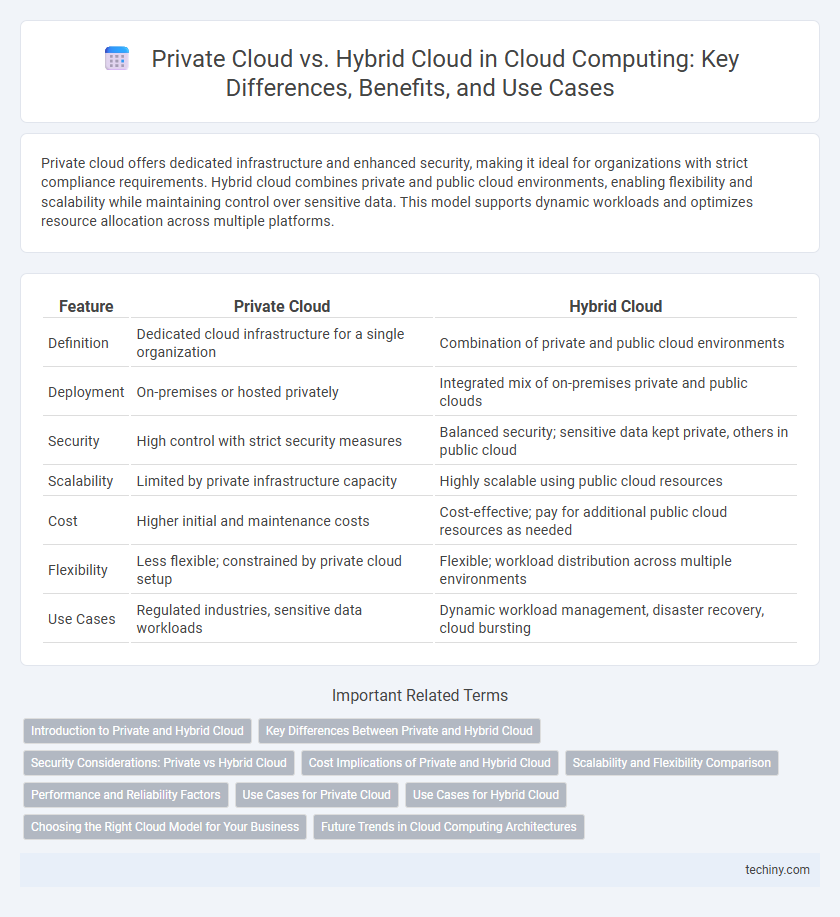Private cloud offers dedicated infrastructure and enhanced security, making it ideal for organizations with strict compliance requirements. Hybrid cloud combines private and public cloud environments, enabling flexibility and scalability while maintaining control over sensitive data. This model supports dynamic workloads and optimizes resource allocation across multiple platforms.
Table of Comparison
| Feature | Private Cloud | Hybrid Cloud |
|---|---|---|
| Definition | Dedicated cloud infrastructure for a single organization | Combination of private and public cloud environments |
| Deployment | On-premises or hosted privately | Integrated mix of on-premises private and public clouds |
| Security | High control with strict security measures | Balanced security; sensitive data kept private, others in public cloud |
| Scalability | Limited by private infrastructure capacity | Highly scalable using public cloud resources |
| Cost | Higher initial and maintenance costs | Cost-effective; pay for additional public cloud resources as needed |
| Flexibility | Less flexible; constrained by private cloud setup | Flexible; workload distribution across multiple environments |
| Use Cases | Regulated industries, sensitive data workloads | Dynamic workload management, disaster recovery, cloud bursting |
Introduction to Private and Hybrid Cloud
Private cloud offers dedicated infrastructure exclusively for one organization, enhancing security, control, and customization compared to public cloud environments. Hybrid cloud integrates private and public clouds, enabling seamless workload migration and optimized resource allocation across on-premises and external platforms. Organizations leverage hybrid cloud to balance scalability with data privacy by combining the best features of both private and public clouds.
Key Differences Between Private and Hybrid Cloud
Private cloud environments provide exclusive infrastructure dedicated to a single organization, ensuring enhanced security, compliance, and control over data and resources. Hybrid cloud combines private cloud with public cloud services, enabling workloads to move between environments for greater flexibility, scalability, and cost-efficiency. Key differences include ownership, with private clouds maintained internally or by a single provider, while hybrid clouds leverage multiple platforms, integration complexity, and varied management approaches for optimized performance.
Security Considerations: Private vs Hybrid Cloud
Private cloud environments offer enhanced security by providing dedicated infrastructure that limits exposure to external threats and allows for strict access controls tailored to specific organizational policies. Hybrid clouds combine private and public cloud resources, creating complex security challenges that require robust encryption, consistent identity management, and comprehensive monitoring across both environments to mitigate risks. Effective security strategies in hybrid clouds depend heavily on seamless integration of security protocols and compliance frameworks to protect sensitive data while leveraging public cloud scalability.
Cost Implications of Private and Hybrid Cloud
Private cloud deployment entails higher upfront investment due to dedicated infrastructure and maintenance costs, but offers predictable operating expenses with enhanced security and control. Hybrid cloud combines on-premises private cloud resources with public cloud services, optimizing costs by leveraging scalable public cloud capacity for variable workloads while maintaining sensitive data in private environments. Organizations achieve cost-efficiency by dynamically allocating resources and reducing capital expenditure, balancing performance and compliance requirements across both cloud models.
Scalability and Flexibility Comparison
Private cloud offers dedicated resources that provide high security but can face limitations in scalability due to fixed physical infrastructure. Hybrid cloud combines private and public cloud environments, delivering superior scalability by leveraging public cloud resources during peak demand while maintaining control and flexibility over sensitive data in the private cloud. This approach optimizes IT resource allocation, enabling businesses to adapt swiftly to changing workloads and enhance overall operational efficiency.
Performance and Reliability Factors
Private cloud environments offer enhanced performance by allocating dedicated resources that minimize latency and maximize processing speed, ensuring consistent reliability for critical workloads. Hybrid cloud solutions balance performance by distributing tasks between private infrastructure and public cloud services, optimizing resource utilization while maintaining redundancy for improved reliability. Performance metrics such as throughput and availability are crucial in evaluating these cloud models, with private clouds excelling in controlled environments and hybrid clouds providing flexibility through scalable resources.
Use Cases for Private Cloud
Private Cloud environments are ideal for organizations requiring strict data security and regulatory compliance, such as financial institutions and healthcare providers. These clouds offer dedicated infrastructure that enables customization and control over sensitive workloads, ensuring data privacy and governance. Use cases include hosting mission-critical applications and managing confidential customer data where latency and security are top priorities.
Use Cases for Hybrid Cloud
Hybrid cloud use cases often involve businesses requiring scalable resources while maintaining sensitive data on private clouds, such as financial institutions managing regulatory compliance alongside dynamic workload demands. Enterprises running big data analytics or disaster recovery typically leverage hybrid models to balance cost-efficiency and security. Hybrid cloud environments enable seamless integration of on-premises infrastructure with public cloud services, optimizing performance for applications needing flexible compute resources and consistent data governance.
Choosing the Right Cloud Model for Your Business
Selecting the appropriate cloud model depends on factors like data security requirements, scalability needs, and budget constraints. Private clouds offer dedicated resources and enhanced security for sensitive workloads, while hybrid clouds provide flexibility by integrating private infrastructure with public cloud services for optimized performance and cost-efficiency. Analyzing workload characteristics and compliance standards is critical to aligning cloud adoption with business goals.
Future Trends in Cloud Computing Architectures
Private cloud deployments emphasize enhanced security and compliance through dedicated infrastructure, while hybrid cloud architectures combine private and public clouds for greater flexibility and scalability. Future trends in cloud computing architectures point toward increased adoption of hybrid models that leverage edge computing and AI-driven automation to optimize resource allocation and reduce latency. Advancements in interoperability standards and multi-cloud management tools are expected to further streamline integration across diverse cloud environments.
Private Cloud vs Hybrid Cloud Infographic

 techiny.com
techiny.com